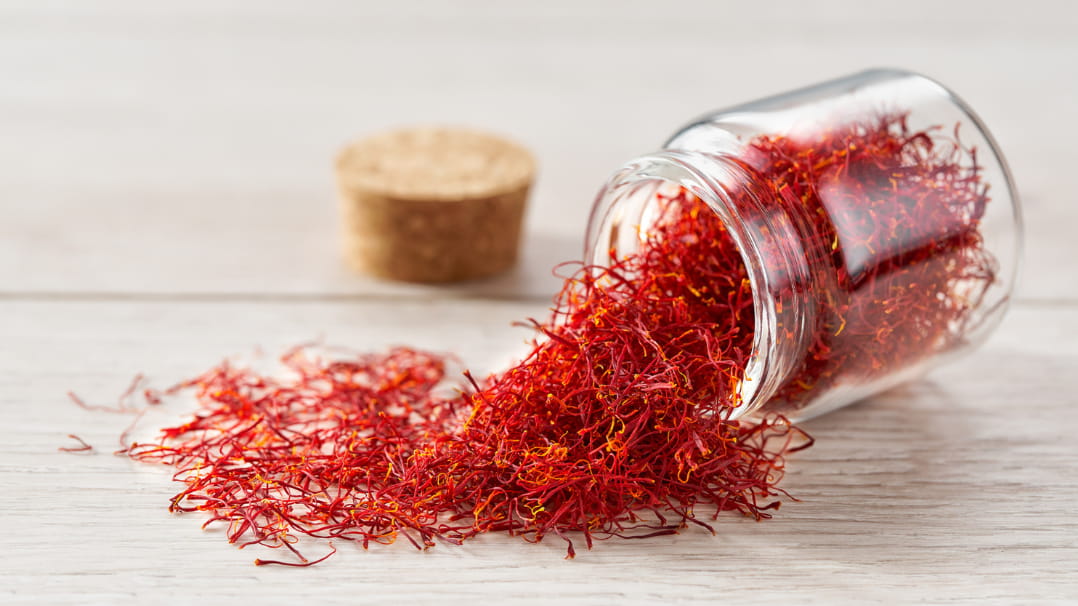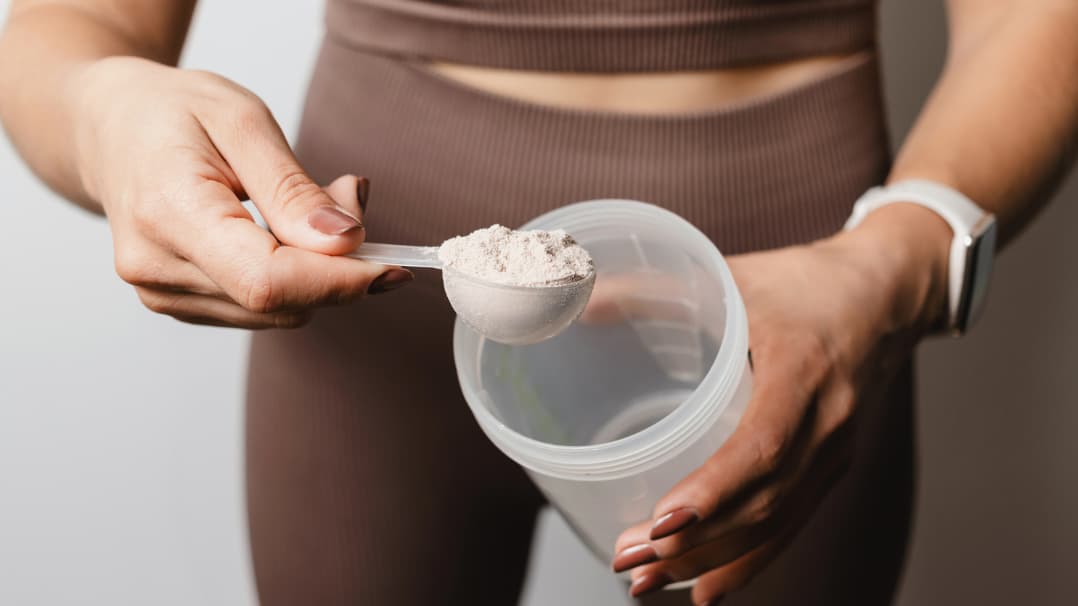What is Saffron?
Saffron is a spice derived from the deep red-maroon colored stigmas of the flowers of Crocus sativus. Saffron has been used and traded as a spice for at least 4000 years; its pleasant flavor, aroma, and color make it a prized spice in many cuisines. However, each flower produces only three stigmas that must be hand-harvested and carefully dried, which makes saffron a costly spice—it is considered the most expensive spice in the world by weight.
Saffron is also widely recognized for its health benefits. Saffron has a long history of use in traditional health practices and a long list of traditional uses, including supporting relaxation, sleep, mood, and being used as a nerve and heart tonic.*
Saffron Health Benefits
Saffron has several bioactive compounds with strong antioxidant properties that may benefit human health, including crocin (a carotenoid responsible for saffron's color), picrocrocin (a bitter compound that gives the characteristic taste), and safranal (which gives the fragrance), as well as zeaxanthin, lycopene, and other carotenoids. Because of the potential benefits of the many antioxidants found in saffron, there has been a growing interest in its use for supporting health and well-being [1].*
Here are some examples of notable studies using saffron that highlight potential saffron extract benefits:
Supports healthy stress responses* (PubMed 37447245)
Supports a positive and calm mood* (PubMed 28735826)
Supports sleep duration and quality* (PubMed 33925432)
Supports healthy vision* (PubMed 30343354)
Supports exercise recovery* (PubMed 24915175)
Does Saffron Support Brain Function?
Saffron has been shown to support several aspects of brain health, which is one of the reasons why we included a saffron stigma extract in Qualia Mind®. In preclinical studies, saffron supported brain antioxidant defenses and natural neuroprotective functions [2–9], which may underlie the benefits of saffron in supporting healthy brain aging in humans [10–13].* Saffron also supported signaling by the neurotransmitters dopamine and glutamate [14] and the growth factor brain-derived neurotrophic factor (BDNF), involved in several aspects of brain function, including neuroplasticity and mood regulation [15–17].* Learn more about why we included saffron in our article “Qualia Mind Ingredients”.
Can Saffron Support a Healthy Mood?
The mood benefits of saffron were another important motive for its inclusion in Qualia Mind®. Saffron’s mood benefits have been studied in several randomized, placebo-controlled clinical trials, which have shown that saffron supports a positive mental-emotional bias and a relaxed mood [18–20].* For example, in a clinical trial with healthy young men, a single serving of a saffron extract supported healthy biological and psychological acute stress responses [21]. In a clinical trial with healthy adults reporting low mood, a saffron extract supported a positive and calm mood after 4 weeks of intake [22].*
Can Saffron Support Sleep?
Randomized, placebo-controlled clinical trials have also shown that saffron supports healthy sleep [23–28].* In studies with healthy adults with unsatisfactory sleep, taking saffron in the evening for 4 weeks was associated with benefits in participants’ ratings for sleep quality, restorative sleep, and mood after awakening [23,25].* In individuals with poor sleep associated with restlessness and agitation, taking a saffron extract for 6 weeks supported sleep duration and sleep quality [26].* In preclinical research, bioactive compounds found in saffron supported NREM sleep [27,28].* These benefits of saffron were one of the reasons we included it in Qualia Night®. Learn more about it in our article “Qualia Night Ingredients”.
How Saffron Supports Vision
The antioxidant effects of saffron can be particularly helpful for our eyes, especially for people who are constantly exposed to screens and other sources of light that can promote oxidative stress in the retina.* This is a benefit we also wanted Qualia Mind® to support. Saffron has been shown to support the body’s natural protection of retinal cells from light-induced stress and to promote healthy retinal function in several preclinical studies [29–35].* In clinical studies, saffron also supported healthy retinal function and helped to maintain healthy structure and function of the macula, an area at the center of the retina responsible for sharp, clear central vision that often shows age-related changes that affect our visual health [36–39].*
Is Saffron Safe to Take Daily?
As is true for most of the things we ingest, the tolerability of an ingredient depends greatly on the amount taken and on each individual’s specific sensitivities. Saffron, as a spice, is generally recognized as safe to be used in food [40]. For botanical extracts, the specific characteristics of an ingredient, such as the extraction process or standardization for specific compounds, can make a difference to its tolerability. The highest recommended serving of saffron stigma extract in our products is 30 mg per day, which is an amount that has shown a good tolerability profile in several clinical studies. No significant adverse effects were observed when this amount was taken for up to 12 months [10–12,41].*
What’s The Recommended Dose of Saffron for Health Benefits?
The specific characteristics of a botanical extract—the extraction process or standardization for specific compounds, for example—and the ingredients with which it is combined can influence the amount of extract necessary to obtain health benefits. Also, different health benefits may be observed at different doses. Furthermore, individual subjective responses to some botanical extracts may also vary considerably, as is the case with saffron. Therefore, there is no specific recommended dose for health benefits that applies to all saffron extracts. We choose the recommended serving of saffron in our products based on clinical studies, the purpose of including saffron, and the other ingredients in the formula.
*These statements have not been evaluated by the Food and Drug Administration. This product is not intended to diagnose, treat, cure, or prevent any disease.
References
[1]R.A. Mir, A. Tyagi, S.J. Hussain, M.A. Almalki, M.T. Zeyad, R. Deshmukh, S. Ali, Plants 13 (2024) 1467.
[2]S. Gudarzi, M. Jafari, G. Pirzad Jahromi, R. Eshrati, M. Asadollahi, P. Nikdokht, Nutr. Neurosci. 25 (2022) 1137–1146.
[3]B. Naghizadeh, M.T. Mansouri, B. Ghorbanzadeh, Y. Farbood, A. Sarkaki, Phytomedicine 20 (2013) 537–542.
[4]S. Purushothuman, C. Nandasena, C.L. Peoples, N. El Massri, D.M. Johnstone, J. Mitrofanis, J. Stone, J. Parkinsons. Dis. 3 (2013) 77–83.
[5]S.V. Rao, Muralidhara, S.C. Yenisetti, P.S. Rajini, Neurotoxicology 52 (2016) 230–242.
[6]Y.S. Batarseh, S.S. Bharate, V. Kumar, A. Kumar, R.A. Vishwakarma, S.B. Bharate, A. Kaddoumi, ACS Chem. Neurosci. 8 (2017) 1756–1766.
[7]L. Tamegart, A. Abbaoui, R. Makbal, M. Zroudi, B. Bouizgarne, M.M. Bouyatas, H. Gamrani, Acta Histochem. 121 (2019) 171–181.
[8]P. Haeri, A. Mohammadipour, Z. Heidari, A. Ebrahimzadeh-Bideskan, Anat. Sci. Int. 94 (2019) 119–127.
[9]S. Soeda, K. Aritake, Y. Urade, H. Sato, Y. Shoyama, Adv Neurobiol 12 (2016) 275–292.
[10]M. Farokhnia, M. Shafiee Sabet, N. Iranpour, A. Gougol, H. Yekehtaz, R. Alimardani, F. Farsad, M. Kamalipour, S. Akhondzadeh, Hum. Psychopharmacol. 29 (2014) 351–359.
[11]S. Akhondzadeh, M.S. Sabet, M.H. Harirchian, M. Togha, H. Cheraghmakani, S. Razeghi, S.S. Hejazi, M.H. Yousefi, R. Alimardani, A. Jamshidi, F. Zare, A. Moradi, J. Clin. Pharm. Ther. 35 (2010) 581–588.
[12]S. Akhondzadeh, M. Shafiee Sabet, M.H. Harirchian, M. Togha, H. Cheraghmakani, S. Razeghi, S.S. Hejazi, M.H. Yousefi, R. Alimardani, A. Jamshidi, S.-A. Rezazadeh, A. Yousefi, F. Zare, A. Moradi, A. Vossoughi, Psychopharmacology 207 (2010) 637–643.
[13]M. Tsolaki, E. Karathanasi, I. Lazarou, K. Dovas, E. Verykouki, A. Karacostas, K. Georgiadis, A. Tsolaki, K. Adam, I. Kompatsiaris, Z. Sinakos, J. Alzheimers. Dis. 54 (2016) 129–133.
[14]H. Ettehadi, S.N. Mojabi, M. Ranjbaran, J. Shams, H. Sahraei, M. Hedayati, F. Asefi, JBBS 03 (2013) 315–319.
[15]T. Ghasemi, K. Abnous, F. Vahdati, S. Mehri, B.M. Razavi, H. Hosseinzadeh, Drug Res. 65 (2015) 337–343.
[16]F. Vahdati Hassani, V. Naseri, B.M. Razavi, S. Mehri, K. Abnous, H. Hosseinzadeh, Daru 22 (2014) 16.
[17]E. Corridori, S. Salviati, M.G. Demontis, P. Vignolini, C. Vita, A. Fagiolini, A. Cuomo, P. Carmellini, C. Gambarana, S. Scheggi, Phytother. Res. 39 (2025) 1277–1291.
[18]H.A. Hausenblas, D. Saha, P.J. Dubyak, S.D. Anton, J. Integr. Med. 11 (2013) 377–383.
[19]A.L. Lopresti, P.D. Drummond, Hum. Psychopharmacol. 29 (2014) 517–527.
[20]W. Marx, M. Lane, T. Rocks, A. Ruusunen, A. Loughman, A. Lopresti, S. Marshall, M. Berk, F. Jacka, O.M. Dean, Nutr. Rev. 77 (2019) 557–571.
[21]C. Pouchieu, L. Pourtau, J. Brossaud, D. Gaudout, J.-B. Corcuff, L. Capuron, N. Castanon, P. Philip, Nutrients 15 (2023).
[22]G. Kell, A. Rao, G. Beccaria, P. Clayton, A.M. Inarejos-García, M. Prodanov, Complement. Ther. Med. 33 (2017) 58–64.
[23]A.L. Lopresti, S.J. Smith, P.D. Drummond, Sleep Med. 86 (2021) 7–18.
[24]A. Tajaddini, N. Roshanravan, M. Mobasseri, A. Aeinehchi, P. Sefid-Mooye Azar, A. Hadi, A. Ostadrahimi, Int. J. Clin. Pract. 75 (2021) e14334.
[25]A.L. Lopresti, S.J. Smith, A.P. Metse, P.D. Drummond, J. Clin. Sleep Med. 16 (2020) 937–947.
[26]B.D. Pachikian, S. Copine, M. Suchareau, L. Deldicque, Nutrients 13 (2021) 1473.
[27]M. Masaki, K. Aritake, H. Tanaka, Y. Shoyama, Z.-L. Huang, Y. Urade, Mol. Nutr. Food Res. 56 (2012) 304–308.
[28]Z. Liu, X.-H. Xu, T.-Y. Liu, Z.-Y. Hong, Y. Urade, Z.-L. Huang, W.-M. Qu, CNS Neurosci. Ther. 18 (2012) 623–630.
[29]R. Maccarone, S. Di Marco, S. Bisti, Invest. Ophthalmol. Vis. Sci. 49 (2008) 1254–1261.
[30]F.D. Marco, S. Romeo, C. Nandasena, S. Purushothuman, C. Adams, S. Bisti, J. Stone, Am. J. Neurodegener. Dis. 2 (2013) 208–220.
[31]A. Laabich, G.P. Vissvesvaran, K.L. Lieu, K. Murata, T.E. McGinn, C.C. Manmoto, J.R. Sinclair, I. Karliga, D.W. Leung, A. Fawzi, R. Kubota, Invest. Ophthalmol. Vis. Sci. 47 (2006) 3156–3163.
[32]M. Yamauchi, K. Tsuruma, S. Imai, T. Nakanishi, N. Umigai, M. Shimazawa, H. Hara, Eur. J. Pharmacol. 650 (2011) 110–119.
[33]B. Lv, T. Chen, Z. Xu, F. Huo, Y. Wei, X. Yang, Int. J. Mol. Med. 37 (2016) 225–232.
[34]R. Natoli, Y. Zhu, K. Valter, S. Bisti, J. Eells, J. Stone, Mol. Vis. 16 (2010) 1801–1822.
[35]L. Chen, Y. Qi, X. Yang, Ophthalmic Res. 54 (2015) 157–168.
[36]A. Lashay, G. Sadough, E. Ashrafi, M. Lashay, M. Movassat, S. Akhondzadeh, Med Hypothesis Discov Innov Ophthalmol 5 (2016) 32–38.
[37]B. Falsini, M. Piccardi, A. Minnella, C. Savastano, E. Capoluongo, A. Fadda, E. Balestrazzi, R. Maccarone, S. Bisti, Invest. Ophthalmol. Vis. Sci. 51 (2010) 6118–6124.
[38]G.K. Broadhead, J.R. Grigg, P. McCluskey, T. Hong, T.E. Schlub, A.A. Chang, Graefes Arch. Clin. Exp. Ophthalmol. 257 (2019) 31–40.
[39]M. Piccardi, D. Marangoni, A.M. Minnella, M.C. Savastano, P. Valentini, L. Ambrosio, E. Capoluongo, R. Maccarone, S. Bisti, B. Falsini, Evid. Based. Complement. Alternat. Med. 2012 (2012) 429124.
[40](n.d.).
[41]M.H. Jabbarpoor Bonyadi, S. Yazdani, S. Saadat, BMC Complement. Altern. Med. 14 (2014) 399.







No Comments Yet
Sign in or Register to Comment